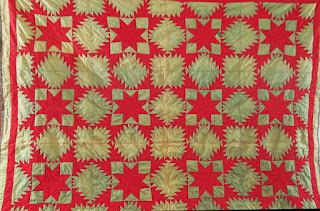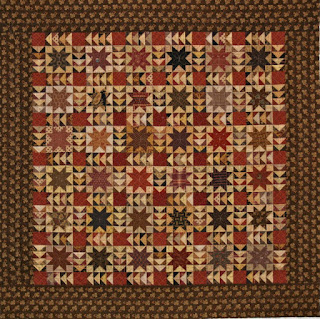Reproduction star with a faded green by Becky Brown
We're moving forward in time to the end of the 19th century. One important change in the last quarter was dyers' experiments with synthetic dyes.
Star quilt from about 1880 to 1920, when
green dyes were very unreliable.

But some of the new dyes were failures. The star points here have
faded to what dyers called a dun color---no color.
What hue were these stars when the quilt came out of the frame?
Close examination sometimes reveals color in the seams
where the light didn't hit the fabric. These may have been
red and yellow stars.
Natural chrome orange was valued because it didn't easily fade.
Quilt date-inscribed 1874
There are remnants of blue in the star points. This
was perhaps once a red, white and blue quilt. Turkey red
cost more but was worth the price.
A green star with the center faded to a grayed-blue.
Detail from a tree block in a quilt date-inscribed 1904.
The tan triangles were probably once a dark green.
You don't see many bright green tree blocks from 1880-1920
when the pattern was so popular.
This one's a block never used so it
probably hasn't seen much light or washing.
What color was that faded green?
Probably a rich, dark green with a slight blue cast as in the border here.
You can see the green fading where the light has hit
it on a fold.
Many solid colors were fugitive, fading to khaki with
washing or light.
Star quilt top from 1890-1920
The peachy reds were probably once a bright red.
A new synthetic red called Congo red often faded to this shade.
Reproduction Fabrics
Fugitive dyes presents the reproduction quiltmaker with a philosophical question. When interpreting the end-of-the-19th-century look, should one copy faded solids?
Both red and blue here have faded.
But other dye disasters are not such happy accidents
You see a lot of faded greens in end-of-the-century
Pennsylvania quilts.
You have a range of greens to work with today, some intense;
others approximate the old fugitive greens.
At the top of the image above some Moda Bella Solids with intense greens;
below that green line I drew: taupes and khakis.
Becky faded her own green. She started with the Kelly green in the frame
and then she...
"abused it to create The Look.
First I gave it a little swim in a jar of mild bleach water (washed and dried).
Next I gave it a soak in a solution of Hydrogen Peroxide and water (washed and dried).
And then I boiled 6 black walnuts in a pan of water (yucky) and tossed in the fabric.
That pretty much took care of changing the original green fabric to something close to a dun color. Of course, I could have done it all with photoshop, but this was much more fun."
Solids weren't the only textiles that faded.
Green calicoes at the time were also fugitive, as was thread.
Quilt dated 1897 in an embroidery thread that faded to pale gray.
What to Do With Your Stack of Stars?
Sash them with Flying Geese
Quilt from the 1880s, attributed to Mechanics Falls, Maine,
by dealers Woodard & Greenstein.
The stars are 3 inches!
Stars and geese are pieced of several late-19th- century print styles including cretonnes, bronzey browns and red robe prints, which we will be discussing in the following weeks.
If one were making this quilt with our 6" stars each of those geese in the sash would finish to 1-1/2" x 3". The cornerstones would be cut 3-1/2"
Rhubarb Crisp by Jo Morton
Jo Morton drew a pattern for an excellent copy (fewer stars, however)
Maureen at Pursuit of Quilts brightened up Jo's pattern
by using madder oranges for those cornerstones
She planned to use one of my red paisleys on the reverse.
Apparently, I've enticed Mareen into making more star blocks
(That is a good thing.)
One More Thing About Fading & Bleeding Cottons
Fading dyes created a whole new market for home dyes.
1922 ad for Diamond Dyes,
"Any woman can dye or tint her old worn, faded things new."
Notice the green and reds on her line.
It wasn't only washing that faded the colors. Light was an enemy. And some of those unstable solids just faded away with time, closed up in the blanket chest.
Early red artificial dyes also bled (they still do).
The binding on this quilt is bleeding into the blocks.
The green leaves in the corners have faded.
Women's magazines were full of helpful hints as to how to launder the new cottons:
1915
"Wonders Can be Accomplished With Starch and Gasoline"
Mostly bad advice.
Do not try this at home.
More on faded greens here:































6 comments:
I think I have a Green that has already been faded to use this week. Thanks for all the fabric education! I'm having SEW MUCH FUN making these Stars.
We are so fortunate today to have all of the dyes we have. Just to think of what the average housewife/quilters took on just when they did the wash!
Thanks Barbara, as always you blogs are so chuckful of interesting information, I could sit for hours re-reading them.
I do have one question. We all seem to have to have our irons hot and ready as we piece blocks. Realizing what having a hot iron in the Civil War era entailed, did they actually press every seam?
Smiles, JulieinTN
I doubt it. A lot of people today don't press till done with the block.
Thank you Barbara. Seeing those antique quilts and thinking of them being made... I just wondered.
Smiles, JulieinTN
New fabric colors to search out - fun! Thanks for this explanation of the fading, and examples of the colors.
How much did the minerals in people's well water affect how the dyes changed? Hard vs. soft, etc.?
Truth in advertising isn't that old, is it? I remember a school dress that was "washable". The fabric was but the trim shrank and bled. I remember women would remove the buttons from a dress before washing and then fasten them back with special safety pins.
Thanks for all you do,
Lu Anne in Texas
Post a Comment